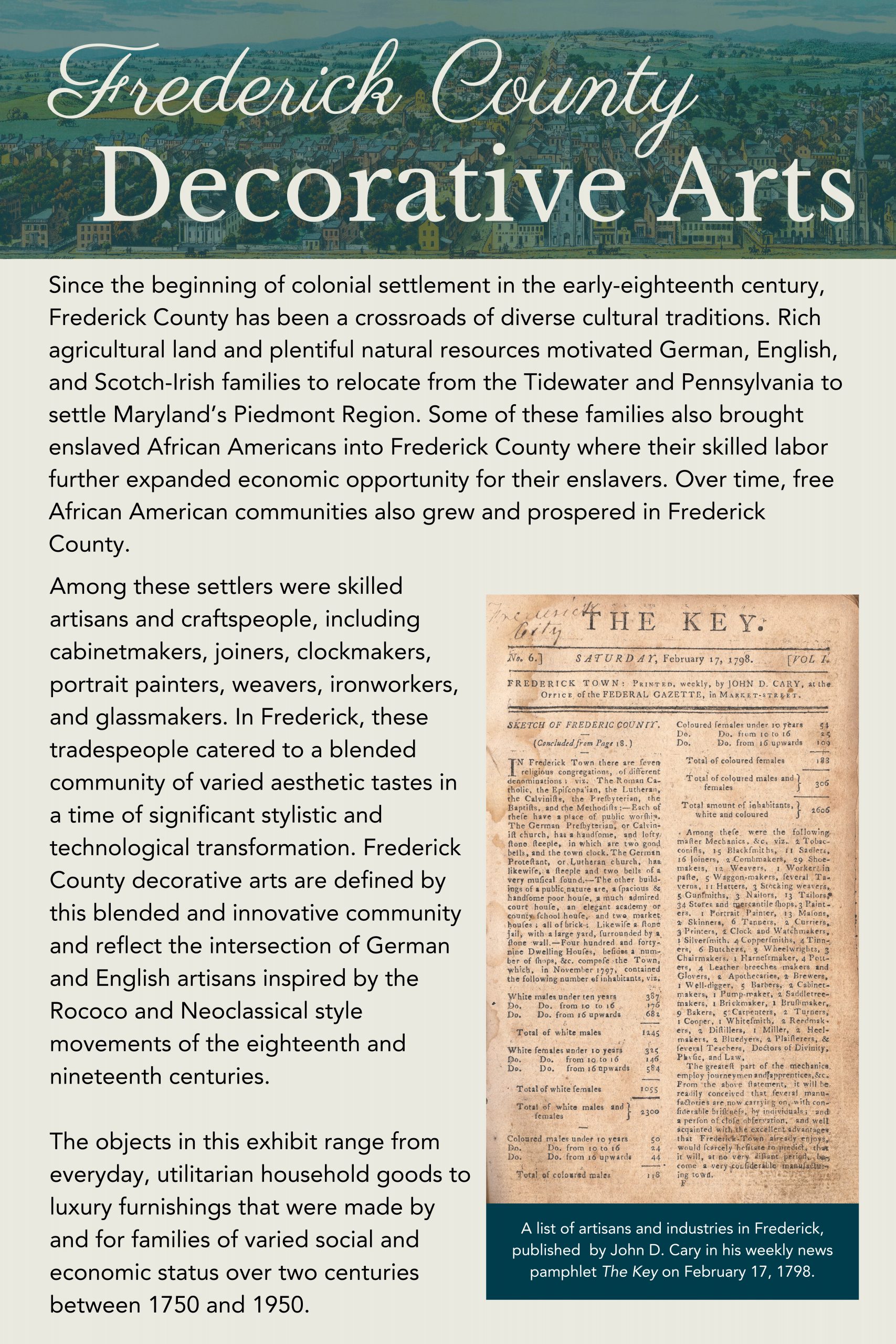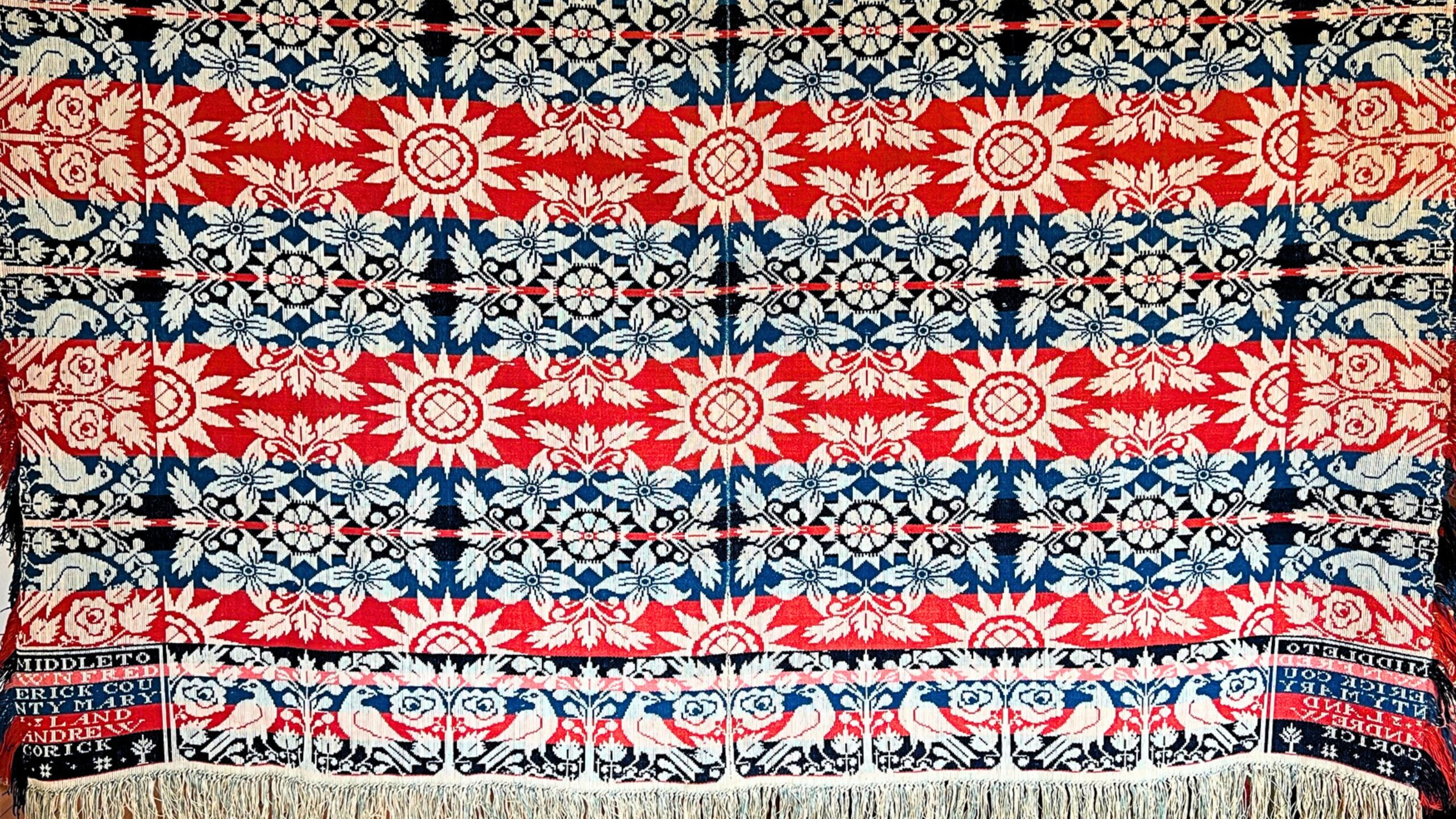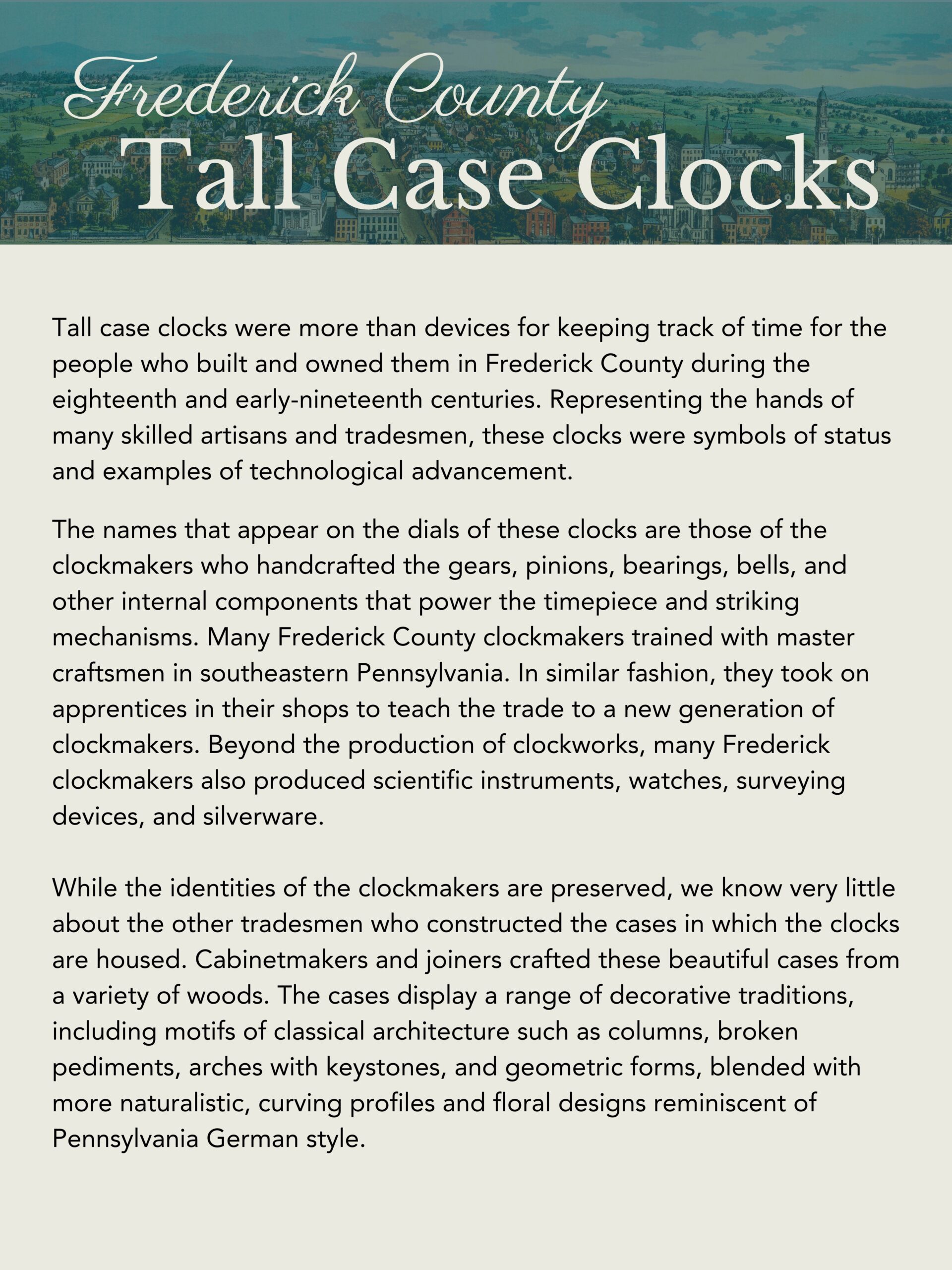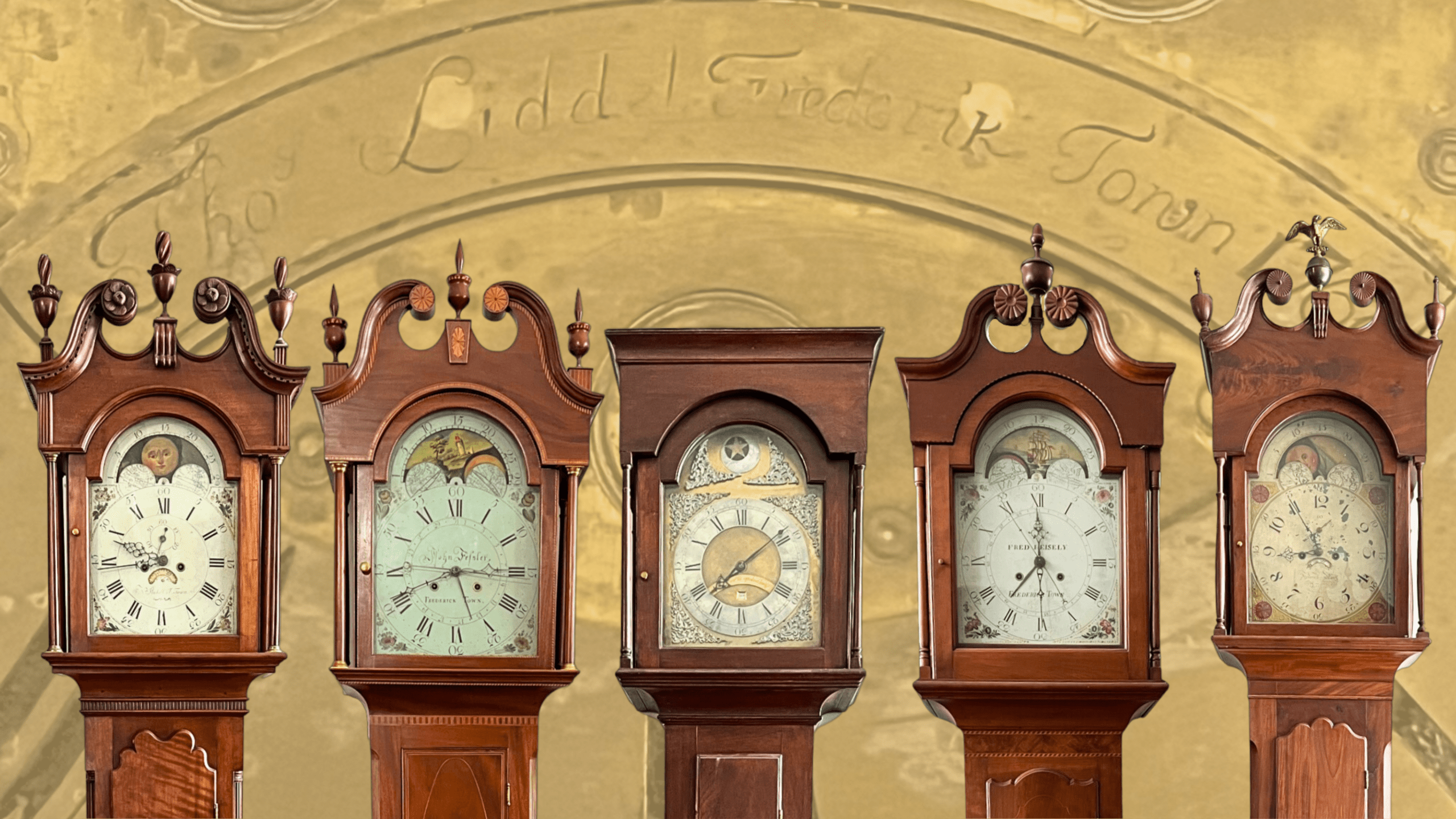
Glass and Ceramics
Case Bottle, one of a pair
New Bremen Glassmanufactory, Gift of the Estate of Mrs. James Brand
John Frederick Amelung immigrated to Baltimore in 1784, bringing several glassmakers and their families to settle in southeastern Frederick County. Amelung purchased a glassworks established in the 1770s and renamed it the New Bremen Glassmanufactory. The skilled German artisans at work in Amelung’s glassworks produced bottles of different styles and purposes, drinking glasses, and window glass. The factory was especially known for its highly-detailed presentation pieces, such as this case bottle, one of a pair, made in 1788 for Baker Johnson, brother of Maryland’s first governor, Thomas Johnson. Within a decade of its opening, the Amelung glassworks suffered a fire that destroyed part of its factory complex. At the same time, Amelung was struggling to market his products against cheaper imported glass from Europe. The Amelung glassworks went out of business in 1794.

Bundt Cake Pan, Inkwell, Flower Pot, Pitcher, and Wash Basin
Ceramic by James C. Mackley, Gift of Charles M. Mackley



Families of every class in Frederick County utilized ceramics such as earthenware and stoneware to prepare and consume food and beverages, bathe, and perform other household tasks. In the 1840s, Jacob Lynn established a pottery in Mechanicstown (Thurmont) and hired potters Anthony Bacher and James C. Mackley. Bacher, considered the founder of the Shenandoah Valley Style, likely instructed Mackley before establishing his own pottery near Winchester, Virginia in 1862. Mackley remained in Mechanicstown and produced utilitarian pottery such as the ink well, flower pot, and bundt cake dish, as well as highly decorative pieces like the wash basin and pitcher. The Shenandoah Valley Style of pottery was directly influenced by Pennsylvania German decorating traditions, using flora and fauna for ornamentation. Mackley continued making pottery until ill health forced him to leave the business by 1883.
Portraiture

Portrait of Joseph Van Swearingen
Oil on canvas by John Johnson Markell, Gift of John Call Leroy
John Johnston Markell was born in Frederick in 1821 to Samuel and Amelia Schley Markell. He was educated at the Frederick Academy where his father was a professor. Markell was a self-taught artist who painted portraits and landscapes. His career led him to Philadelphia and later to Leesburg, Virginia, before returning to Frederick where he painted this portrait of Captain Joseph Van Swearingen [1799-1837]. Depicted in his military uniform, the subject of the portrait died on December 25, 1837 at the Battle of Okeechobee, an engagement in the Second Seminole War between the United States and the Seminole People of Florida who were resisting their forced relocation to a reservation in Oklahoma. John Markell died at the age of 23 in 1844, just five years after completing this portrait.
Painting of the Courthouse Square Fire
Oil on canvas by Helen M. Smith, Gift of James Burger
On March 31,1842, embers carried by the wind from a fire at the residence of Dr. William Tyler on Record Street threatened to ignite the roof of the Frederick County Courthouse. The valiant efforts of the Independent Hose Company were immortalized by John Markell who painted a banner depicting the firefighters climbing onto the roof and using their hand-pumped apparatus to extinguish the flames. In 1945, Frederick-born artist Helen Leona Smith [1894-1997] reproduced Markell’s century-old banner painting in oil on canvas. This scene was one of many depictions of Frederick County’s landscape and history that Smith painted during her lifetime. She sold artwork and accepted commissions through her own studio, The Palette Shop. Smith died at the age of 103 in 1997.

Metalwork

Kettle
Copper and Brass by Matthias Zimmer, Museum Purchase
Matthias Zimmer was born in Germany in 1749 and immigrated to North America, settling in Frederick by 1772 when he married Maria Elisabeth Mohrin at Evangelical Lutheran Church. Zimmer was a coppersmith who crafted household goods and tools from copper and brass. This kettle from his shop bears his name imprinted on the handle. Records indicate that Zimmer also produced piping and fittings for James Rumsey who successfully demonstrated an early steam-powered boat on the Potomac River near Shepherdstown, Virginia (now West Virginia), in 1787, one year after Mathias Zimmer’s death.

Stove Plate
Cast Iron by the Catoctin Iron Furnace, Gift of the Francis Scott Key Memorial Association
Brothers James, Baker, Roger, and Thomas Johnson established Catoctin Furnace in 1776 in northern Frederick County. Using a workforce of skilled laborers, many of whom were enslaved, the furnace produced stoves, tools, and in the latter years of the Revolutionary War, ammunition for the Continental Army. The furnace produced stoves for heating and cooking, including one made from ten plates known as a “Catoctin Stove.” This stove plate is signed “I Johnson 1776” (“I” standing for James) and is decorated in Rococo style.

Serving Spoons and Teaspoon
Silver, nickel, and copper by John Fessler, Sr., John Fessler, Jr., and Frederick Nusz, Gifts of the Children of Mildred Staley, Mary Angel Sappington and Louise Sappington, and Museum Purchase
Frederick County clockmakers frequently supplemented their business by applying their skills at crafting metal to producing silverware. These various spoons were produced in Frederick by local clockmakers John Fessler, Sr., John Fessler, Jr., and Frederick Nusz. Each piece is crafted from coin silver, a composite material of pure silver alloyed with either copper or nickel. Coin silver was a popular standard in the United States in the first half of the nineteenth century. After cutting blanks from melted-down ingots, the silversmith hammered the handle and bowl, stamping the reverse with their name.
Furniture

Slant-Top Desk
Cherry by Conrad Doll, Gift of the Estate of Jacob Edward Engelbrecht
The history of this desk, a finished piece by skilled cabinetmaker Conrad Doll, was recorded on the inside of its drawers and document cases by its second owner, Frederick diarist Jacob Engelbrecht (1797-1878). His annotations state that Conrad Doll built the desk in 1787 for John Brunner. The primary wood is cherry and the cabriole feet with their distinctive spurs on the inside curve are characteristic of the Chippendale Style in which Doll worked. The decorative architectural elements, quarter-round columns on the corners of the cabinet, and the fluted columns and arch with keystone applied to the prospect door, are common features of Frederick County’s classically-inspired vernacular style of the late-eighteenth century.


Side Chair
Walnut with cloth upholstery by an unknown maker, Gift of the Francis Scott Key Memorial Association
The influence of Thomas Chippendale is evident in this early example of a Frederick County side chair. The flat crest rail and vasiform splat, which form the back of the chair, are copied directly from Plate IX in Thomas Chippendale’s 1754 The Gentlemen and Cabinet-Maker’s Director. The heavy construction of the base and the bold inward curvature of the back legs are common characteristics among eighteenth century Frederick County chairs.

Side Chair
Painted wood by an unknown maker, Gift of Regina Rodock Raggi
The bamboo-form turnings on the posts and legs of this Windsor chair are common to the Federal period of the early-nineteenth century. The chair is believed to have belonged to Barbara Fritchie [1766-1862], a Frederick resident who became a national heroine during the Civil War thanks to John Greenleaf Whittier’s 1863 eponymous poem. With stylistic elements similar to Pennsylvania Windsor side chairs, this chair could have been made in Pennsylvania (where Fritchie’s family lived prior to settling in Frederick) or by a journeyman chairmaker from that State who came to Frederick for work.

High Chair
Oak by Frederick and Christopher Stottlemyer, Gift of Melanie S. Fouche
Local cabinet and chair makers remained active in the smaller communities of rural Frederick County long after their urban counterparts transitioned to selling mass-produced furnishings. From the 1850s until 1921, the Stottlemyer family of Wolfsville carried on a chairmaking workshop. This high chair was made by either Frederick Stottlemyer [1830-1913], the founder of the family business, or his son, Christopher [1857-1931]. Early Stottlemyer chairs were constructed using mortise and tenon joining with wooden tree nails. The curved shape of the arms evoke the Neoclassical style, which was popular when Stottlemyer began making chairs.

Side Chair
Poplar by James Whitehill, Gift of Mr. and Mrs. David H. Stockwell
Based in ancient Greek and Roman culture, Neoclassical furniture was popular in the United States during the first half of the nineteenth century. Baltimore was a center of furniture production in the Neoclassical style, including the popular painted “Fancy Chair.” Local cabinetmakers such as Frederick’s James Whitehill [1798-1874] copied this style in their own production. This chair is made of poplar painted and ornamented with gilded stenciled designs.
Corner Cupboard
Walnut and glass by an unknown maker, Museum Purchase
Corner cupboards were a common furnishing among Frederick County households, maximizing storage while occupying minimal floor space. This cupboard displays characteristic Frederick County design elements such as spurred Chippendale styled feet and the use of architectural components. Note the wooden moldings on either side of the doors that rise to a flared cornice, imitating a column and capital. The unusual geometric patterns cut into the wood surrounding the drawers and cupboard doors are similar to “punch and gouge” decoration commonly seen in Federal-era houses throughout Frederick County.
Textiles

Sampler
Silk on linen by Julia Hoffman, Gift of Polly Spencer

Sampler
Silk on cotton by Salome Fundenburg, Gift of Robert G. Shanahan in honor of Ann Kemp
From an early age, girls learned to sew and embroider to help produce or repair garments and other textiles for their families. Samplers offered the opportunity to demonstrate one’s skills with a needle and thread, but they also were an expression of the maker’s education, culture, and spirituality. These samplers were crafted by two Frederick County women in the early-nineteenth century.
Salome Fundenburg was thirty-one years old when she made this sampler in 1808, possibly while she was teaching someone else to sew and embroider. Born in Mechanicstown (Thurmont), Salome’s family immigrated to Maryland from Germany. Her sampler is adorned with stylized designs of trees and flowers, a common art form in the German tradition.
In contrast to the colorful and varied design of Fundenberg’s sampler, Julianna Hoffman’s 1822 sampler is more subdued and simple, reflecting the Quaker style that originated from Pennsylvania. The Hoffman family were not Quakers themselves, but Julianna may have learned to embroider from a Quaker teacher at Bush Creek in southeastern Frederick County near her family’s home.
Coverlet
Dyed cotton by Andrew Corick, Gift of Virginia Brosius
This coverlet was made by Andrew Corrick, a Middletown weaver working from the mid 1830s to the mid 1840s. He is only known to have used two different center field patterns, “Double Lily and Sunburst” and “Double Rose,” and he used the same border pattern, “Bird and Rose Bush,” for both. He typically signed his work in the corner block, with the location and his name, as he has in this example.
The piece exhibited here has a centerfield pattern of “Double Lily and Sunburst” and a border pattern of “Bird and Rose Bush.”
Andrew Corrick was born in Germany in 1791 and immigrated to the United States, settling in the Middletown Valley, by 1818. He married Catharina Kopp. He was a weaver and a farmer and the couple had two children, a son, Joshua, who also became a weaver, and a daughter, Caroline, who married weaver and machinist, Frederick K. Uber. Andrew Corrick died in 1863 and is buried at the Middletown Reformed Cemetery, Middletown.





